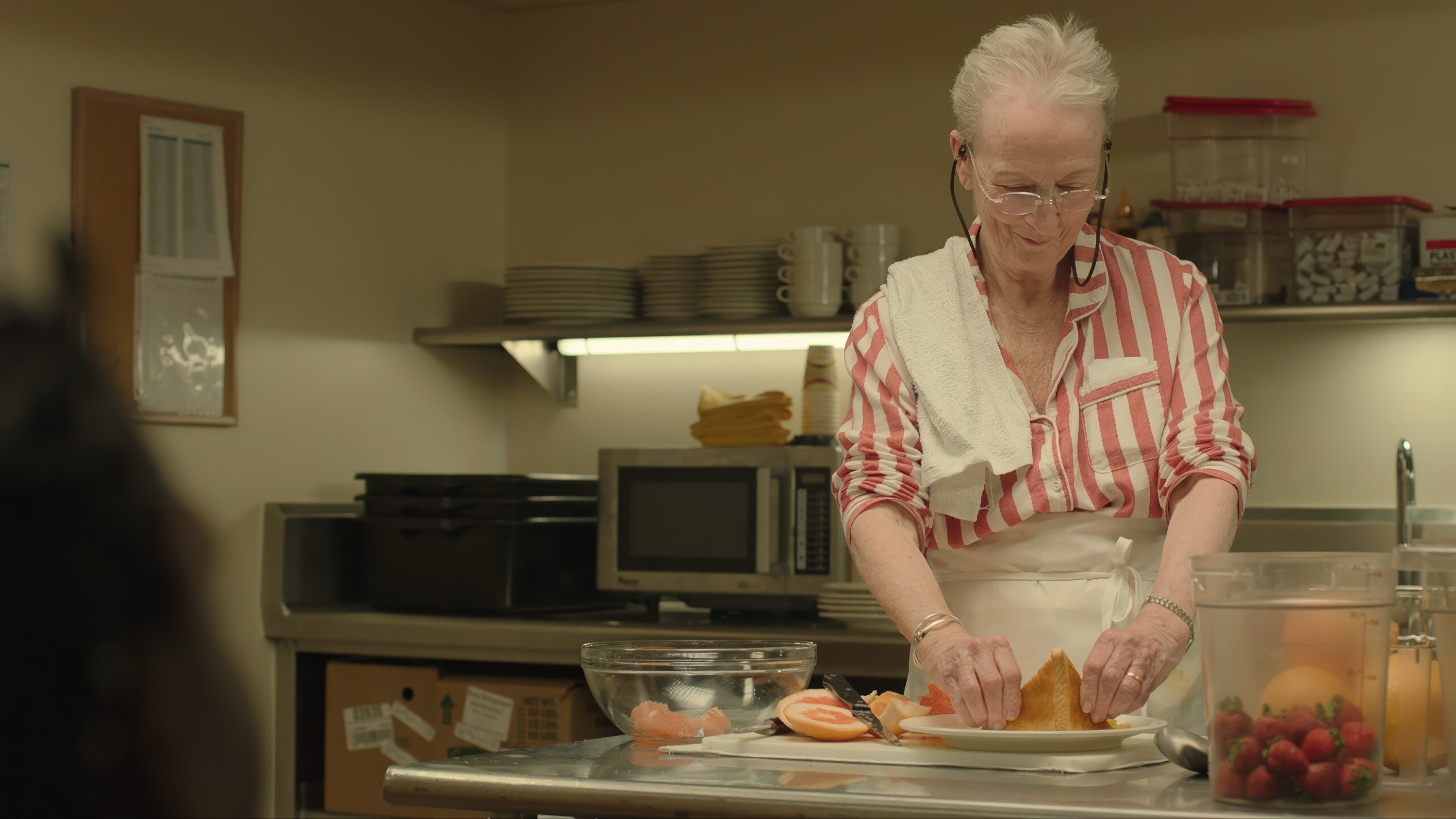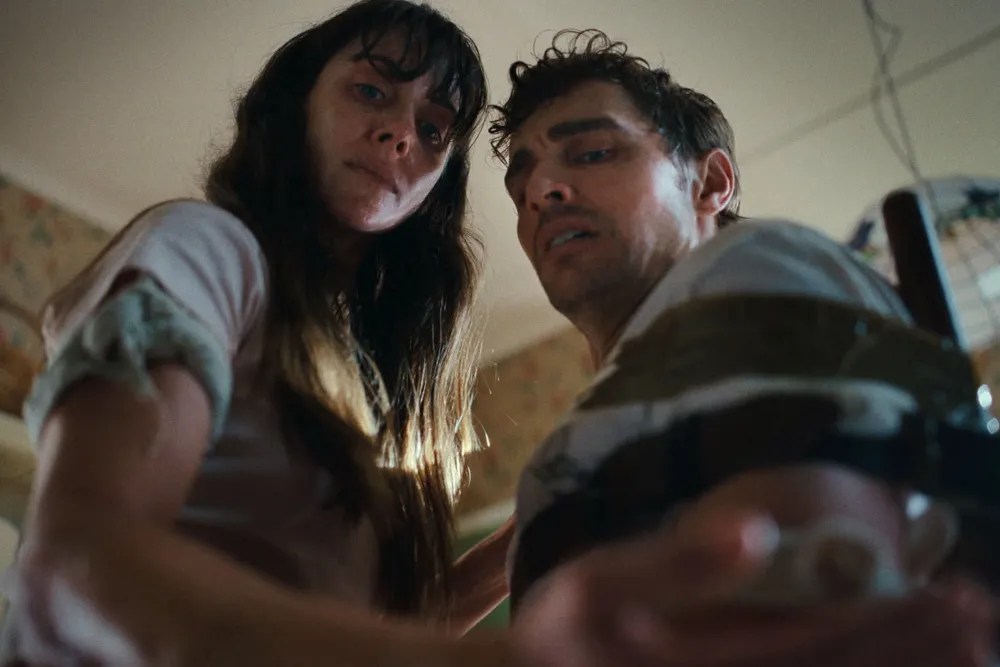Location, location, location. When it came time for filmmaker Sarah Friedland to make her first feature, the Venice winner “Familiar Touch,” it wasn’t just a case of “this would be a nice location to have” or “think of the location as another character in the film.” It went completely beyond those elements, as Friedland opted to not only set her film in a Southern California retirement community, but to film it at one too — with the help of actual residents.
“I think we tend to think about aging communities and particularly aging communities where there is care provided as spaces where people go to die rather than spaces of living,” Friedland told IndieWire during a recent interview. “So I thought, OK, if we turn a retirement community into a film set, that is part of anti-ageist politics, to say a care setting can actually be a site of cultural production. We were working with a tiny budget, we couldn’t ever pay to take over or create a retirement community. This felt like a way to have an exchange: We are going to offer this educational experience for residents and staff alike, and in exchange, you’ll help us make this. We could have this sort of reciprocal creative swap.”
Friedland’s film premiered at Venice in the Orizzonti (Horizons) section last year, where it won the Luigi de Laurentiis Lion of the Future prize for best first film, plus the Best Director award for Friedland, and the Best Actress award for star Kathleen Chalfant. In the achingly intimate drama, we follow Chalfant’s Ruth as she attempts to acclimate to a new life (and where it will eventually take her) over the course of her early days in an assisted living facility and, specifically, in its memory care unit.
“The first kernel [of an idea] came [because of] my paternal grandmother many, many years ago,” Friedland said. “She was a poetry editor, an intellectual, and someone whose sense of self was very much rooted in her linguistic expression, and when she developed dementia, she became nonverbal after a certain point. My family, in grieving the person they knew, started speaking about her in the past tense.”
At the time, Friedland was studying dance, and she couldn’t help but notice that, even without words, her grandmother was expressing herself through movement. “She was still very physically present and expressive,” the filmmaker said. “She would rock. She would tap certain rhythms. She would reach out to touch you. I could feel a kind of friction between the narrative — which is not specific to my family — that we use generally to talk about people with memory loss, that they’re no longer there or they’ve slipped away.”

Friedland, who was only in her early teenage years at the time, said she was “haunted” by this feeling and this friction for years. She wrote the first draft of the script that would become “Familiar Touch” when she was just 19.
“I was trying to figure out if I could write,” she said. “At the time, I thought that screenwriters were people who had a penchant for writing dialogue, and I didn’t. I thought of everything in movement. … The first script was trying to imagine [the character who would become Ruth] moving around her home of decades for the last time, it was just kind of imagining those day-to-day activities and that choreography.”
Friedland said she stuck that first script in a drawer, finished college, and started working various jobs in the film industry, from production coordination to script supervising. But Friedland, who often wears multiple hats on her own film (editor, choreographer, and more), was itching for a different kind of experience.
“I got to a point where I felt like, if I want to make humanist dramas, I need to meet people who aren’t working on a film set,” she said. “Otherwise, I’ll just be one of those filmmakers who only makes films about film people.”
She quit her job — at the time, she was the script supervisor for HBO’s “Girls” — and answered an ad for a sculptor with dementia who needed a caregiver who could serve as half-studio assistant, half-care companion.
“That job changed everything I thought I knew about aging, about the intimacy of care work, about age identity,” she said. “After doing that, I started teaching filmmaking to older adults. During those years, I was constantly revising the script. Those experiences working with older adults is where the idea emerged that it needed to be made in this way. It just felt like, if I want to make this anti-ageist drama, let’s bring older adults into the process of making it and recognize their talent and capaciousness and make it in a sort of intergenerational way.”
While the film follows Ruth during a period of transition, it was essential to Friedland that the film not slip into worn-out ideas about what aging means or what it looks like, especially to those not experiencing it for themselves.
“I was thinking about this film as a sort of anti-ageist film in a number of ways,” Friedland said. “Usually films about aging present a drama of decline. Whether it’s memory loss or healthy aging, the drama is about a person withering away or sliding into decrepitude, and it’s a tragedy around that. It’s not to say there aren’t losses around aging, of course there are, but there are at every stage of life. And one of the ways that those stories are perpetuated is that they’re from the perspective of younger people looking at older people, rather than the older person looking at themselves.”

“Familiar Touch” is told, brilliantly, from Ruth’s perspective. It’s not given over to histrionics or blaring displays of emotion, instead asking us to follow Ruth and experience the world through her eyes. The impact is profound.
“This is where being a care worker really informed the script, because what I saw with my clients is that the people around them, their loved ones who meant very well, they were the ones who had the tones of tragedy in their voice,” she said. “The people I was caring for, they didn’t see themselves as protagonists in a tragedy, they were just living a drama that was sometimes comedic, sometimes sad. The first move for me was just being very clear that this had to be rooted in Ruth’s sense of self and her relationship to people, rather than them looking at her.”
Through that perspective, we can temporarily feel the way Ruth must. Confused. Scared. Tricked. As disconcerting as it might feel to never quite know what Ruth is going to do next, that choice breeds understanding. How would that feel if you were the person on the inside? Friedland and Chalfant explore that in many ways.
“The other thing that was really important was showing Ruth’s sexuality,” the filmmaker said. “It’s part of how this manifests on screen as well, older women in particular having sexuality is usually the butt of a joke, so I wanted to show Ruth’s desire in a way that really honored it and that felt like it had a sensuous language in the filmmaking grammar. I wanted to give viewers a sense that an older person is no different than us, with the hope that a young person could watch it and identify with Ruth’s desire, her ambition, her gutsiness. It’s such a dumb thing to say because it’s so obvious, but to feel her as just a person.”
And Friedland had plenty of experience working with older people to help guide those intentions. In 2017, she made a short film entitled “Home Exercises” that followed a handful of older adults in their own homes. The filmmaker said she quickly noticed that so many of her performers were just as interested in the mechanics of filmmaking as they were in performing for the camera.
The idea to film at Villa Gardens involved many moving parts and big questions (who would be involved, what would they do on the set, what about residents who didn’t want to be involved, how would they handle medical emergencies, and so much more), but it all started with the residents themselves.

Friedland said that the community’s executive director, Sean Rushforth, “made it very, very clear what they needed for this to be done in a way that felt right for them and allowed us to sort of adapt our plan to meet that.” Friedland and her producers offered a production plan to the residents that they voted on.
“I’m very used to pitching the film to funders, producers, et cetera, but maybe my most nervous pitch was when I pitched it to a 200-person room of residents to get their green light,” Friedland said. “And thank God they said yes. I really appreciated how clear they were about what was needed to do this, not only with consent, but enthusiastic consent.”
Friedland conducted a five-week filmmaking workshop with the residents leading up to production of “Familiar Touch,” with the idea that the residents would gravitate toward different aspects of filmmaking that could be put to use on the feature. “The hope was that people would find themselves in these different crafts and then be able to help us make this in a way that was authentic,” she said. “I love intergenerational experiments. For me, this was kind of this strange pedagogical intergenerational experiment, and part of that comes from the sense that a crew can be a really dynamic and generative social relationship, and it allows people to relate to each other in ways that they might not in another setting.”
She’s showed the film to the Villa Gardens residents twice now: a group of residents and staff came to Los Angeles’ AFI FEST premiere in October (there were so many people, Friedland shared happily, that they couldn’t all fit on the red carpet) and, the next day, Friedland took the film directly to the community, so that those who were unable to travel could see it, too. “Packed house, standing room only, and we brought the [Venice award statues] lions and everyone got to pass them around,” she said. “Their overwhelmingly positive critical reception means more to me than anything.”
While the process by which Friedland made “Familiar Touch” was highly specific — the story so intrinsically linked to the setting in which it was actually made — the filmmaker is hopeful that the lessons she learned on the film are replicable for her and other creators.
“I hope more people will think about older adults as people that they can collaborate with and that have valuable things to contribute,” she said. “I think we live in a society that thinks that people, once they receive care, no longer have anything to give, and that’s just so not true. I hope more people will consider collaborating with aging communities.”
Music Box Films will release “Familiar Touch” on Friday, June 20 at Film Forum in New York and Friday, June 27 in Los Angeles, and will be expanding nationally in select markets.



